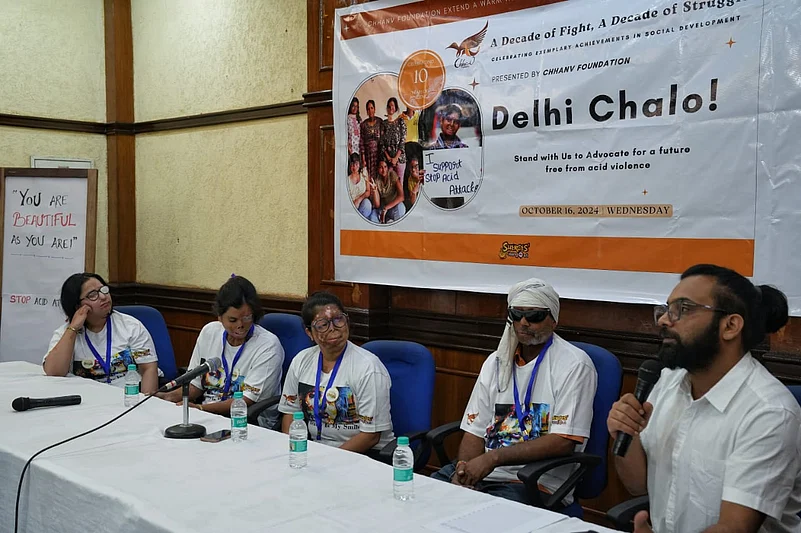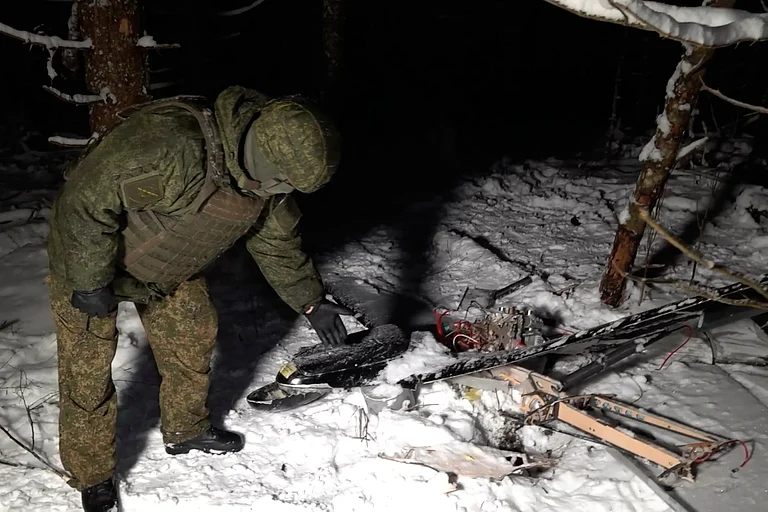Two years ago, Kajal thought her dream to become an IAS officer was crushed forever when a jilted lover entered her home in the middle of the night and threw acid on her. She was in Class 10 then and couldn’t finish her education. But she did not lose hope. On October 14 this year, Kajal became the District Magistrate (DM) for a day in Mau district in Uttar Pradesh giving her a glimpse into the life she wanted. “I was very nervous and scared but also had a sense of curiosity. It has always been my dream to become an administrative officer and this was the perfect opportunity for me to learn,” she says.
Hope is everything for an acid attack survivor. Like Kajal, Antima too wanted to land a government job but the wait would be longer than she anticipated. She had appeared for government job entrance tests and prepared for the National Cadre Corps (NCC). However, on July 11, 2023, she was attacked with acid while she was at her home in Ayodhya. Antima alleges that she is yet to receive the compensation that the government provides to acid attack victims. She is currently undergoing treatment at the Trauma Centre in Lucknow. Without the compensation, she is unable to afford the bills for her full recovery.
“Poverty is the biggest deterrent for most acid attack survivors in India,” says Alok Dixit, founder of Chhanv Foundation, in a press conference in New Delhi. “A majority of the attacks happen on young girls and many of them are unable to even return to school. The government compensation, at Rs 3 lakh, barely covers a few initial costs of treatment while most survivors need lifelong adjustments,” he says.

In a survey conducted with 200 survivors, Chhanv Foundation found that 93 per cent of survivors come from families with an annual income of less than Rs 1.5 lakh, 83 per cent of survivors are under 35 years old, meaning they were attacked during the crucial years of their education or while trying to build their careers, and over 85 per cent of these attacks target women and children, making it even harder for them to re-enter society and lead normal lives.
Julie was only 5 years old when she survived an acid attack. The attacker was her biological father and it was not meant for her. “I don’t remember much from that now. My father had come to attack my mother and my stepfather but in the dark, he mistook me for her. He was angry because she had remarried,” she says. While she survived, her stepfather succumbed to his injuries. Julie suffered grave deformities from the attack. Her head was attached to her shoulder and it took years of painful surgeries to fix it. Chhanv Foundation had brought Julie from Fatehpur to Noida several years ago for rehabilitation. She has been with the Sheroes ever since.
Most often, acid attack survivors need a series of surgical procedures, such as skin grafting, reconstructive surgery, eye surgery and so on. These are high-cost procedures and are usually not found at a single hospital, or sometimes, even in the same city or state.

Acid attack is generally seen as an adverse form of gender-based violence as a majority of the victims are women. It involves brutalisation of women’s face and body using a corrosive substance – usually sulphuric acid – and leaves the victims often with permanent scars, disfigurations, disabilities and severe health problems in case they survive.
It has been 10 years since the Chhanv Foundation started the Stop Acid Attacks campaign. They have been fighting against the sale of acid as well as advocating for better laws and swifter actions against the perpetrators. Over the years, the organisation has taken several steps to bring relief to survivors and their families, their rehabilitation, access to medical recovery, education and training. In 2015, they started their Sheroes Hangouts project and launched cafes in Lucknow, Agra and Noida, in collaboration with UPWCD.
In 2013, the Supreme Court banned the over-the-counter sale of acid nationwide. It also directed the state governments to issue acid-sale licences to only select retailers who were directed to keep a record of those buying acid, after checking their ID proof. However, acid continues to be readily available at local stores, facilitating incidents of acid attack.

In many cases, it does not end with one acid attack but results in prolonged harassment by the attacker, especially if the victim survives. Sangeeta and her husband were walking on the street when a few men who had enmity with her husband threw acid at them. “It was in 2019 when my husband and I were attacked. My children – 11 and 13 – got us admitted to the hospital. I had to sell my land to afford the treatment. Luckily I also got the support of Sheroes (Chhanv) and then received my compensation. But my attackers did not like that,” she says.
In 2023, Sangeeta’s daughter was murdered by the same people who threw acid at them. “For three months, I tried to file an FIR and then went to court to get the case registered. The case is still pending,” she says. She breaks down as she recalls but quickly finds resilience in her voice. “All I want now is justice for my daughter. I want those men to be punished.”
‘They Should Be Ashamed’
Often, the mental agony left behind by the attack are harsher than the acid burn scars. The incident leaves an indelible mark on the memory of survivors who then often find it difficult to reintegrate into society. Their faces become eternal targets of discrimination and injustice by society. Kajal was disowned by her relatives and the people of her village in Jharkhand after the incident.
In five out of 10 cases, acid attacks are perpetrated by a family member in situations of domestic violence, sexual harassment and family disputes. Narrating her story, Roopa from Faridabad talks about how she continues to fight this discrimination after her own family members threw acid on her and her daughter.

“My daughter and I were attacked by my own family. They wanted me to never show my face to them again but I still go there. I let my neighbours also look at me; I show my face to everyone because there is nothing to hide. They are the ones who should be ashamed.”
When the incident happened, Roopa’s daughter had to leave her school. They tried getting re-admission after the surgeries but “the school just wouldn’t take her back,” she laments. Roopa’s daughter has not found the courage yet to be okay with her life after the incident. She rarely leaves her room. Her mind gets clouded with thoughts about what people will say when they look at her.
“Many survivors struggle with self-blame and societal rejection. We need stronger support systems, both legal and emotional, to help these individuals reintegrate into society,” says co-founder Ashish Shukla.

However, many acid attack survivors have found the strength to live happily again. For Seema Rajput, a survivor from Ayodhya, nothing could bring her down. In 2016, she was attacked by her brother’s friends over some tiff. This was a week after they injured her brother by causing a motorbike accident. “We did not have toilets at home then, so I had to walk a long distance to go to one. It was 6:05 am when they brushed past and threw acid on me,” she recollects.
Though the attack was intended to destroy her and her brother’s life, Seema notes that perhaps they could not. Sharing her story about finding love after her attack, she remembers how she did not reply to her now-husband for months when he first texted her on social media. “I did not know how to read so I could not understand what he used to say. After my training at Sheroes, I learnt to read and write and we started chatting. Today I am married to him. He takes good care of me,” she says, blushing.
According to the National Bureau of Crime Records (NCRB) (2022), West Bengal has reported the highest number of acid attack incidents (31), followed by Uttar Pradesh (25). Across the country, 124 incidents of acid attacks were reported that year with 140 victims. However, these are only the official records and the actual number of cases is expected to be much higher.
The Chhanv Foundation has declared the establishment of Acid Attack Awareness Day to be observed annually on February 4, starting in 2025.
"The only way we can defeat the purpose of the crime and the criminal is to change our response as a society. If everyone starts supporting and embracing survivors, the criminal’s intention to destroy their lives will be defeated," says Alok Dixit.

























